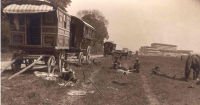Using the archive to work with communities
 At Surrey Heritage, we seek to preserve a history of Surrey that is representative of all communities in the county. Several years ago we examined our archive holdings to see what communities were not well represented. We found that we had only a small collection of archive material relating to the Gypsy, Roma and Traveller population, although these communities had lived in Surrey for hundreds of years. What little information we had was difficult to find and seldom written or donated by the community; there were local authority records concerning Gypsy sites and legislation, but few stories or recollections from individual communities.
At Surrey Heritage, we seek to preserve a history of Surrey that is representative of all communities in the county. Several years ago we examined our archive holdings to see what communities were not well represented. We found that we had only a small collection of archive material relating to the Gypsy, Roma and Traveller population, although these communities had lived in Surrey for hundreds of years. What little information we had was difficult to find and seldom written or donated by the community; there were local authority records concerning Gypsy sites and legislation, but few stories or recollections from individual communities.
To address this issue, we worked initially with a Romany Gypsy journalist who carried out research in the community to find out if they wanted a presence in the archive and how this should be presented. Following his report, 'Private Past, Public Future', a number of oral histories and photographs were added to the archive.
Meanwhile Surrey Heritage staff worked hard to uncover Romany, Gypsy and Traveller material from the archive, creating an immensely useful guide.
Surrey Heritage then obtained European Union funding to work as lead partner on the Roma Routes project. This enabled Roma, Romany and Gypsies from across Europe to meet and discuss their sense of identity and how this should be represented to the wider public through events and heritage interpretations.
The Roma Routes website was created by the Rural Media Company, the only media company at the time representing and employing Romany, Gypsies and Travellers in the UK. Many of the videos were filmed and edited by members of the community who worked for Rural Media. As part of the project, research was undertaken to gain a picture of the UK archives and museum collections which have items relating to the Gypsy, Roma and Traveller community. Details can be found on the Roma Routes webpage.
Alongside these projects, we have also been using the archive to explain to people today that Gypsies, Roma and Travellers have been part of our community for hundreds of years. Working with the community we have held events at the Epsom Derby and at Bourne Hall and the Rural Life Centre to explain Gypsy and Roma traditions and culture.
Historical and cultural definitions
Gypsies are thought to have arrived in Britain from the northern Indian sub-continent around 1500. The Romany language has its roots in Hindi but suggests a migration via the Middle East into South Eastern Europe. The first reference to Gypsies in England occurs in 1514 and as it was believed they came from Egypt they were first called 'Egyptians'. Roma Gypsies came to England from Eastern Europe just prior to the First World War and again after tensions in the 1930s. From 1956 Hungarian Gypsies have come to England.
Terminology
Identifying historical records is particularly difficult because of the different words used to refer to the Travelling community and to describe their lifestyle. Even today, family history publications use Romany and Gypsy interchangeably. Spellings may also vary in historical records including many variant spellings of Gypsy, such as Gipsy, Gipsie and so on. Welsh Gypsies share the same heritage as English Gypsies, but Scottish and Irish Gypsies and Irish Travellers are all distinct ethnic groups; the latter are often referred to in parish registers as 'Pavees' or 'Minceir'. Historically you may find any of the following terms used: Traveller, vagrant, stroller, tramp/tramper, bargee, sojourner (temporary resident), of no fixed abode, living in tent, van dweller, show, fair and circus people. The words Roma, Romany and Romani, Sinti, Kalderash and Gitano may also be used.

